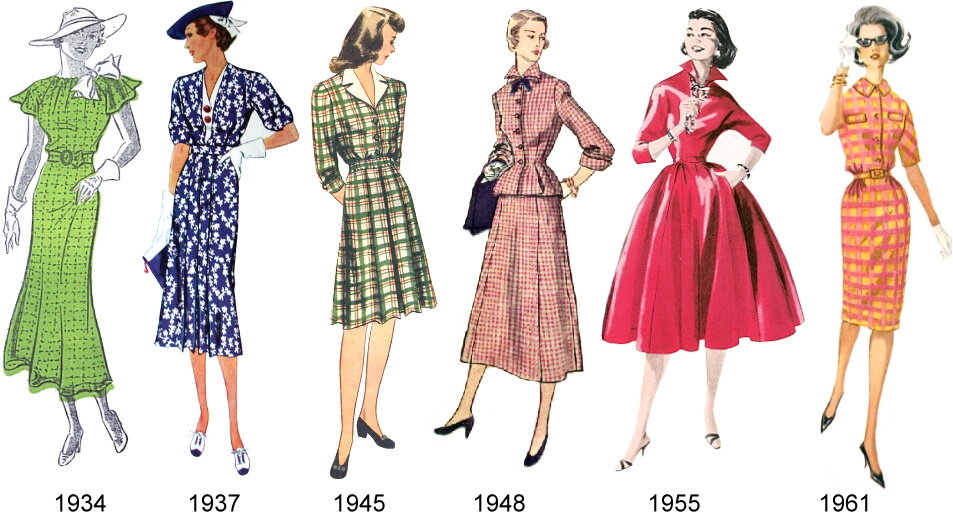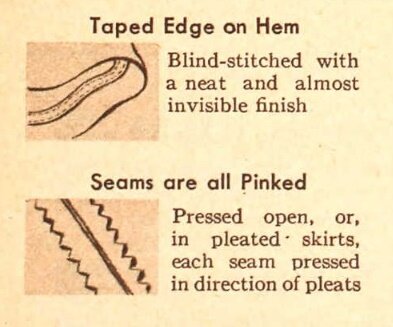I’m revisiting posts from the Tuppence Ha’penny archives, and in some cases updating and expanding the content.
If you want to wear vintage clothing it's very helpful to be able to put a rough date on garments. Even if you don't intend to be a purist about things, it helps to know an item's approximate era in order to avoid overpaying for something that's been misdescribed. Or perhaps you'll find yourself in a charity shop, clutching what you think just might be an original 1950s dress.
I have a quick checklist I work through whenever I spot an item I think might be vintage. None of these on its own will be enough to determine whether a garment is proper vintage, but looking at all together will help you to draw a reasonable conclusion. If you know your stuff there's a chance you might find a bargain that's been mis-labelled as later than it actually is by a seller mistaking the original for the revival.
Style
Obviously, the key factor in dating a garment is the style. My Fashion Eras post gives a brief overview of 20th century styles. Familiarising yourself with dateable sources such as vintage catalogues will give you an appreciation of the finer details which can help more accurately date a garment.
Consider the length of the skirt - the timeline below briefly illustrates skirt styles and lengths from the 1930s to early 60s, although it’s important to note that occasionally earlier vintage dresses were altered shorter at a later time.
Zippers & Closures
After assessing the style of a garment, the very first thing I look at is the style of zip. Plastic zips were uncommon before the 1970s, so if for example you're looking at a circle skirt, a metal zip will be a good sign that it's an original 1950s skirt, while a plastic zip can be an indicator of a later item. Plastic zips with cotton twill tapes are earlier than plastic zips with tapes made in that sort of polyester canvas you see now. Invisible zips were invented in the 1950s but only really became ubiquitous much later, around the late 80s / early 90s. Obviously it's not exactly unknown for an old garment to be given a replacement zip, or for a newly-handmade dress to be sewn (as I do) with a metal zip; so take this along with other factors in your assessment.
Another aspect to note is the placement of the zip; 30s and 40s dresses usually had the zip in the side seam (with a second short zip at the back of the neck, on higher necklines), whereas from the late 50s onwards it became common to place the zip in the centre back. This can be a good thing to look at when trying to distinguish (for example) 70s-does-30s from the real deal.
If there is no zip, but a button or snap placket in the side seam of a dress, it's likely that it dates to pre-1950s. Again I stress this is not a hard and fast rule, but it’s one data point to build up a picture.
Labels
The label can be full of clues as to an item's age. The style of the label itself can be an indicator: early-mid 20th century labels were usually woven, until around the 1960s printed satin labels started to become more common. The logos on the label can provide further clues: earlier labels often feature script fonts, while in the 60s and 70s modern, hippie-influenced fonts were frequently used. The Vintage Fashion Guild has an extensive collection of vintage brand labels, categorised alphabetically, which is a useful reference both for specific brands and to get a feel for the general look and feel of labels from different eras.
If there is a size label this can also help: vintage sizing was smaller than modern, so if it's marked a size 14 but is clearly tiny, chances are it's got some age to it. In British sizing, a size 14 in the 1940s was a 32" bust. By the late 1960s it was a 36" bust and remained so into the early 80s; it's now a 38" bust. If the size label actually gives a "to fit bust" measurement, there's a good chance it's pre-1980s, as the practice of actually clarifying sizing seems to have died out around then.
American- and Canadian-made clothing often has a union label, which can help determine a date range. Clothing with the distinctive CC41 Utility label was produced during the period of fabric rationing, which ran from 1941 to the late 1940s.
A label with fibre content details almost always indicates 1970s or later.
Seam finishings
While the overlocker has actually been around since the late 19th century, it was unusual for seam allowances to be serged or overlocked before the 1960s. Prior to that, the seams of even commercial garments were often pinked. Of course, home-made garments right up to the present often have no seam finishings so again this is not a foolproof rule, but if you find a garment with a brand label and pinked seams, it’s quite likely to be earlier than 1970s.
Seam allowances used to be quite generous, to allow for garments to be let out as necessary. Hems were also generous - often three or four inches deep - and finished with lightweight hem tape and blind-stitching. Modern mass-produced garments usually have a very narrow, machine-rolled hem.
Fabric and Print
If you’ve followed my series on synthetic fabrics, you'll know that polyester wasn't invented until the 1950s, and was labelled under trade names like Dacron and Terylene until at least the 60s. So, anything labelled polyester is generally post 70s (you'd be amazed at how many sellers list polyester-labelled items as original 40s or 50s).
If there is no label, it's possible to determine fabric content using a burn test.
Prints can often be an indicator of age, once you get to know them. It's not something I have the space to cover in detail here, but it's something you can often follow your instincts on. If, for example, that "1950s" dress has a print of squiggles and triangles in primary colours, or a washy watercolour floral, there's a good chance it dates from the 80s.
Sleeves
Sleeve styles are quite distinctive to each era, and so can often be a telltale sign of original vs later copy - 80s-does-50s dresses often have puff shoulders and wide armholes, whereas original 50s designs generally have quite snug-fitting sleeve cuffs. On the other hand, don't automatically assume that a batwing sleeve sweater is 80s - Dolman sleeves were quite popular in the 50s.
Popular sleeve styles in the...
1930s: Sleeves were generally set-in: flutter/butterfly styles were popular through the early-mid 30s, and puffed shoulder lines became popular towards the end of the decade.
early-mid 1940s: Still generally set-in sleeves with a puff (earlier 40s) or darted (mid-40s) shoulder, often with triangular shoulder pads; the shoulder line became stronger and sharper as the decade progressed, until the New Look came into vogue in 1947-48. Bishop sleeves were also seen.
late 1940s - 1950s: once the New Look set in, a sloping shoulder line became de rigeur. Cut-on cap sleeves, raglan and dolman styles were popular. Puff sleeves also appeared, especially on sun dresses and junior styles.
1960s: Sleeveless; Set-in; Raglan; Cap; Bell (very late 60s).
1970s: Angel; Butterfly; Cape; Bell; Leg-o-mutton (Victorian revival); Flounce / Ruffle.
(Note: These are just some of the dominant sleeve styles from each era, as a guide)
In the end...
Whatever your conclusion regards the age of the item, you can now make an informed decision whether to go ahead and part with your cash. So that 1950s dress turns out to be 80s-does-50s? If you like it, don't let that stop you from buying it - just make sure you're paying a price appropriate for 80s vintage and not 50s vintage.
Next in the series: Building a Vintage Starter Wardrobe












